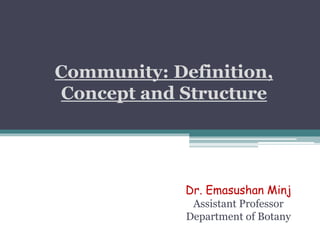
Plant Community- definition, concept and structure
- 1. Community: Definition, Concept and Structure Dr. Emasushan Minj Assistant Professor Department of Botany
- 2. • Definition of Community: “Community represents the population of all species living and interacting in an area at a particular time.” • Population is defined as an adaptation to changes in environmental conditions within limits. • The key driving force of adaptation to environmental changes is believed to be biological evolution, the change in a population’s genetic makeup through successive generation.
- 3. Concept of Community: • A group of organisms comprise population. Each population has characteristics like natality, mortality, age structure, growth dynamics and so on. • Several populations share a common habitat and its resources; they interact among themselves and develop into a biotic community. • Microorganisms, plants and animals populations sharing a common habitat and interacting among themselves develop into biotic communities. • The composition of a biotic community in any habitat is dependent upon the occurrence of environmental conditions in that habitat and the ecological amplitude of species populations.
- 4. • Thus the climate and other abiotic as well as biotic conditions of a habitat determine the type of community which survives and develops. • The organisms of a community usually exhibit trophic (feeding) relationships among themselves. • They also interact in sharing the space and there may be interactions at a reproductive and behavioral level. • Each biotic community exhibits a number of characteristics, such as diversity, density, dominance, composition and stratification, within its special limit. • The transitional zone or junction between two or more diverse communities is called “ecotone”. • The ecotone is a community termed as ecotonal community with organisms of overlapping communities and some of unique types.
- 5. Structure of Community: • Communities may be small, consisting of few species populations in a small space, or large, comprise several species populations in a large area. • The community structures, composition and other characteristics can be readily described by visual observation without actual measurement. • This is a qualitative approach which is easier than the quantitative population analysis where measurements are actually made. • Communities usually categories by the ecologists in various ways primarily based of habitat features like water availability, high exposure, or other habitat features. • For instance, depending on the amount of water availability, plant communities may be hydrophytic (aquatic habitats), mesophytic (moderately moist soil habitat) and xerophytic (dry or arid habitat).
- 6. • Similarly communities growing on conditions of abundant light are called heliophytic and those growing in shade sciophytic. • Identically communities growing on various habitats designated as desert communities, mountain communities and estuarine communities and so on. • In general, a community is dynamic since it changes over time. This dynamic nature is reflected in the succession of organisms in a habitat. • A series of changes results in the development of a relatively stable community, which maintains its structure and influences the climate of the area. • Such a stable and mature community is called a climax community, while communities of successional stages are called seral communities. • The plant community structures, composition and other characterize can be described in both qualitative and quantitative means.
- 7. Community Dynamics: • Communities are dynamic systems constantly interacting with another system, the environment, which is equally dynamic. • The community charges are gradual and imperceptible at any time but eas- ily recognizable if observed at regular intervals over a long period of time. • Seasonal changes in plant communities always occur at every place, particularly in areas where temperature variation is significant. • However, in course of very long period of time at many places the communities have reached a peak stage and attained a dynamic balance with the environmental changes. • The process of change in communities and their environment at one place in the course of time is called “ecological succession”.
- 8. Thank you